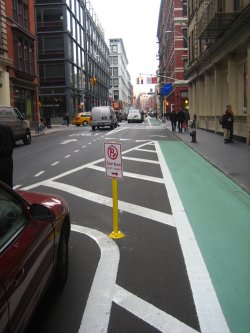Council Candidate’s Congestion Solution: Rush Hour Bike Bans
The Lo-Down, a blog covering the Lower East Side and environs, just wrapped up a slate of interviews with all the candidates running for the 1st District seat in the City Council: Margaret Chin, Pete Gleason, Arthur Gregory, PJ Kim, and the incumbent Alan Gerson. Along with John Liu, Gerson has been one of the council’s most vocal critics of recent safety improvements for pedestrians and cyclists. But after reading up on the views of his competitors, it’s doubtful that dumping Gerson in the September 15 primary — provided he makes it on the ballot — would put a more progressive voice in City Hall.
 1st District Council candidates say safety measures like the Grand Street lane are out of step with their community. Photo: Ian Dutton
1st District Council candidates say safety measures like the Grand Street lane are out of step with their community. Photo: Ian DuttonThe 1st District covers most of Manhattan below Houston Street and parts of Greenwich Village. Perhaps nowhere else in the city is better suited for walking and biking. Or at least that would be the case if not for the punishing traffic that overruns its streets every day.
When it comes to giving their potential constituents some relief from the auto armada, the 1st District challengers have plenty of deserving targets to train their fire on. But forget the placard abuse, the free ride for car commuters who pour over the East River bridges, and the city’s nonsensical truck toll system. Here’s what challenger Arthur Gregory said when asked what he views as the district’s most pressing transportation issue:
You can drive through Central Park at certain times. And certain times
you can’t. Have the bike paths the same way. When there’s congestion
because of cabs, people are going to work, they’re doing business, or
deliveries in the morning then you say, listen, you can’t really use
the bike paths now.
Okay, so Arthur doesn’t get biking as transportation, or the fact that bikes take up much less space than cars. His views on cycling would have come across as backwards even during the dark ages of the Midtown bike ban, 22 years ago. (If only he’d thought this bike thing through as much as his well-reasoned position on delivery truck schedules — read the whole interview, he says some good stuff.)
The thing is, the other candidates don’t compare all that favorably. In fact, they practically trip over themselves to condemn one of the most important cycling safety measures in their district, the protected bike path on Grand Street.
Chin gave the following assessment of the Grand Street bike lane:
Grand Street cuts across many different neighborhoods. You have
different needs and you have different usage, and no consultation. Just
an item on the community board agenda… That bike lane (between
Chrystie and Canal) is the stupidest thing, that’s what people in the
community say. It just created a lot of congestion. But the city says
‘we think it’s a good idea. We just think people will get used to it.’ Wait a minute. You can’t just impose that on a community.
This is a common refrain. It’s easy for the candidates to profess support for safer streets in the abstract, but what about specific projects like Grand Street, or the seemingly unassailable addition of pedestrian refuges to hazardous crossings? Their standard response: Say it’s no good and blame the community process that preceded these real-world improvements.
In the case of the Grand Street bike lane, that process involved a nearly unanimous CB2 vote in favor. The community board system has its flaws, but I think it’s fair to ask: If approval from the local CB doesn’t cut it for these council candidates, what sort of "community input" requirement would they like to see fulfilled before every attempt to make streets safer?
Signed consent from SoHo boss Sean Sweeney?